Media
Transcript
This is the Daily Space for today, Friday, November 13, 2020. I am your host, Beth Johnson, and I am here to put science in your brain. Unfortunately, Dr. Pamela is dealing with a host of grant deadlines, so I’m flying solo today. And now, science.
Sometimes in astronomy, you get lucky. The sky is big, and many astronomically interesting events are extremely rare and brief. This means you have to be looking at exactly the right place at the right time and with the right instrument to detect key events.
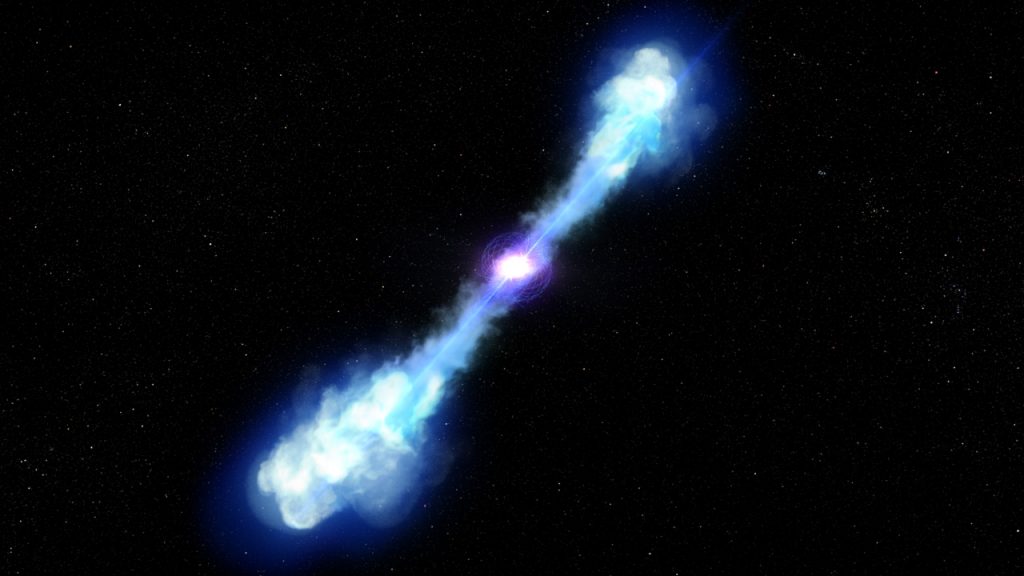
We can increase our chances of catching rare events by keeping survey scopes crawling the sky for flickers of light, and today we have observatories like the Neil Gehrels Swift Observatory keeping watch in gamma-ray light, and the Zwicky Transient Facility is out there watching in visible light. At the same time, many of the world’s telescopes have agreements in place that say “in case of something awesome, drop what you’re doing and go look”.
Back in May, this combination of watching with Swift and dropping everything to go look with just about everything else may have allowed the astronomical community to catch the birth of a magnetar, a special kind of neutron star that has a massive magnetic field capable of releasing tremendous bursts of energy.
It all started with a short flash of gamma-rays. Short gamma-ray bursts (GRBs), events that release massive amounts of energy for less than two seconds, are caused by two neutron stars merging into a new, single object. These events are called kilonovae, and back in August 2017, one such event was observed in light, gravitational waves, and neutrinos. That historic event produced a black hole but it now appears that in some instances, the merging neutron stars take a different, more luminous path.
When the Swift telescope spotted that new short gamma-ray burst in May, it triggered a myriad of telescopes to redirect their efforts to its location in the sky. From Hubble to the Very Large Array (VLA) to Keck, these scopes and many more all measured everything they could, and because Hubble was able to be involved, the observing team quickly realized that the afterglow of light was ten times more luminous than expected. If these merging objects had formed a black hole, the only source of light would have been the warm material shocked during the kilonova. If the merging neutron stars were small enough, however, they could instead form a new, larger neutron star, which would not only be glowing hot but would be transferring energy to the surrounding material via its strong magnetic field.
According to study co-author Tanmoy Laskar: You basically have these magnetic field lines that are anchored to the star [and] that are whipping around at about a thousand times a second, and this produces a magnetized wind. These spinning field lines extract the rotational energy of the neutron star formed in the merger, and deposit that energy into the ejecta from the blast, causing the material to glow even brighter.
Magnetars are fairly rare objects that are thought to most often form via the death of a single massive star. This event – the merger of two smaller neutron stars – shows that magnetars can form in more than one way. It’s thought that this is a rarer way for magnetars to form, but we will need to keep looking and keep getting lucky in order to get a better understanding of the real statistics. For now, this research is published in the Astronomical Journal with lead author Wen-fai Fong.
From getting lucky to getting creative, our stories run the gamut of space science today. My next two deal with water on Venus and Mars and both are from graduate students.
Moa Persson, of the Swedish Institute of Space Physics (IRF) and Umeå University, is defending her doctoral thesis on the subject of just how much water has escaped from Venus’ once-temperate surface out into space, and she has found that the amount is not that much, relatively speaking.

Persson analyzed data collected by IRF’s instrument on Venus Express, ASPERA-4, to determine how many ions were collecting around Venus. These ions turned out to be, on average, one oxygen atom for every two protons, which indicates water. Ionized hydrogen, of course, is one proton. Persson then noted that the level of ion escape varied with the solar cycle, and if something does a thing now, it likely has done a thing in the past.
When the sun is quieter, during solar minimum, more protons escape the atmosphere. During solar maximum, the solar winds are stronger, and the protons end up back in the atmosphere more than they escape. As Persson stated: The surface of Venus today is comparable to hell. It is extremely dry and has a temperature of 460 degrees but historically the surface was more hospitable with a wealth of water that could reach a depth of several hundreds of meters if spread equally over the surface. This water has disappeared from Venus. My thesis shows that only a few decimetres of this water has escaped to space.
Note: A decimeter is one-tenth of a meter.
This research has implications for other planets like Earth and even Mars, which once held liquid water itself, and can be used for comparison to similar studies.
And speaking of Mars, University of Arizona researchers have discovered a surprisingly large amount of water in the upper atmosphere, being rapidly destroyed. Another graduate student, Shane Stone, has analyzed data taken by NASA’s MAVEN mission. He explains: We know that billions of years ago, there was liquid water on the surface of Mars. There must have been a thicker atmosphere, so we know that Mars somehow lost the majority of its atmosphere to space. MAVEN is trying to characterize the processes responsible for this loss, and one portion of that is understanding exactly how Mars lost its water.
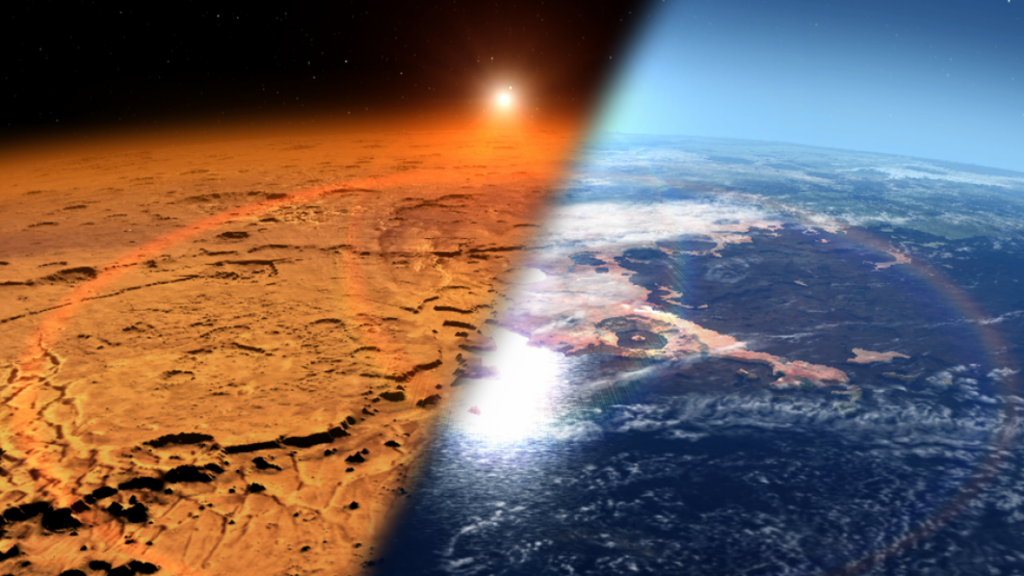
As MAVEN orbits Mars, it dips into the planet’s atmosphere every few hours. The onboard Neutral Gas and Ion Mass Spectrometer (NGIMS) instrument measures the abundance of water ions in the upper atmosphere, 100 miles up from the surface. This measurement allows scientists to infer how much water is present.
Mars’ water loss, it turns out, is mostly affected by the seasons on Mars itself. During the Martian summer in the southern hemisphere, Mars is closest to the Sun and warms up accordingly. At this time, more water changes from ice to vapor and rises into the atmosphere. Regional dust storms that occur about every ten years cause even more heating and more water loss.
Stone goes on to further explain: This is important because we didn’t expect to see any water in the upper atmosphere of Mars at all. If we compare Mars to Earth, water on Earth is confined close to the surface because of something called the hygropause. It’s just a layer in the atmosphere that’s cold enough to condense (and therefore stop) any water vapor traveling upward.
The hygropause on Mars, it seems, is too warm to prevent the water vapor from escaping to the upper atmosphere, and once there, the process is simple for breaking the vapor into ions. The research team then extrapolated these findings back one billion years and found that they can account for the loss of a global ocean about 17 inches deep. And those dust storms could have caused the loss of an additional 6.7 inches of ocean depth, which could explain why Mars is so cold and dry compared to Earth.
Prior to one billion years ago, the hygropause on Mars may have been stronger, so there is still more to be learned about the red planet and its relationship with water.
Liquid water, it turns out, is no longer the only criteria considered important for the habitability of a world. Scientists at the University of California Santa Cruz (UCSC) have found that the amount of radioactive elements, particularly the longer-lived ones, incorporated into rocky planets may be a crucial factor in the potential for life.
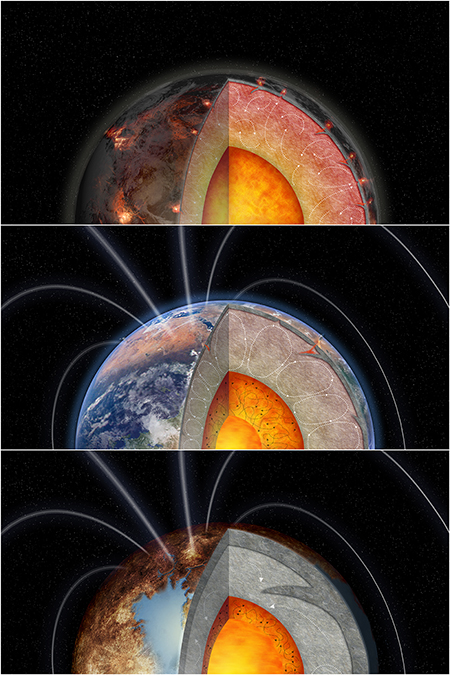
Radioactive decay of heavy elements such as thorium and uranium in the core of Earth drives our plate tectonics and might even contribute to the generation of our magnetic field. That magnetic field helps protect us from dangerous solar and cosmic rays, which helps life survive on the surface. The new findings, published this week in Astrophysical Journal Letters, show that the supply of radioactive elements in the Earth’s core generates more than enough heat to drive the geodynamo that creates our magnetic field.
First author Francis Nimmo explained: What we realized was that different planets accumulate different amounts of these radioactive elements that ultimately power geological activity and the magnetic field. So we took a model of the Earth and dialed the amount of internal radiogenic heat production up and down to see what happens.
It turns out that if a planet has too much radiogenic heating, it cannot sustain a dynamo because the heavier elements end up in the mantle, and a hotter mantle becomes an insulator, preventing the core from losing enough heat quickly enough to generate the convection necessary for a magnetic field. You also end up turning the volcanism to full blast and cause more extinction events.
On the other hand, if the planet doesn’t have enough radiogenic heating, the planet has no volcanism and is geologically dead. Nimmo goes on to note: Just by changing this one variable, you sweep through these different scenarios, from geologically dead to Earth-like to extremely volcanic without a dynamo. Now that we see the important implications of varying the amount of radiogenic heating, the simplified model that we used should be checked by more detailed calculations.
So how does a geodynamo add to habitability? Scientist and exoplanet expert Natalie Batalha explains: It has long been speculated that internal heating drives plate tectonics, which creates carbon cycling and geological activity like volcanism, which produces an atmosphere. And the ability to retain an atmosphere is related to the magnetic field, which is also driven by internal heating.
Once again, we add more pieces to the puzzle of what drives life.
On the other side of the coin, we have processes that have caused the destruction of life. In fact, there have been multiple extinction events in Earth’s past, including the largest such event, the end-Permian extinction, which wiped out 95% of all marine species on Earth. Occurring not long after, scientists found a smaller but nonetheless impactful extinction event called the Carnian Pluvial Episode or CPE. And they have been working to understand that smaller event that came during a time period when our planet was in the midst of recovering from the end-Permian.

The CPE was not a stunning, swift die-off like the other event I already mentioned or the later dinosaur-killing event, and it took scientists working across multiple disciplines to piece together an overview. As they’ve grown to understand the CPE, it turns out that 1) it’s a bigger extinction event than previously thought and 2) it directly led to the ascendency of the dinosaurs.
This most recent work, published in Science Advances, looked at the rainfall from this event. Per the press release: The CPE is named for the stage of the Late Triassic in which it occurred—the Carnian—and for its signature feature: rain. A lot of rain, in four main pulses lasting over a million years, fell across much of the supercontinent of Pangaea.
Along with all the rain, there was global warming as well as ocean anoxia and acidification, killing off a third of the marine species that were left or rose after the end-Permian and leading to further diversification of the remaining species. Study co-author Mike Benton noted that this period led to “the rise of modern reefs and plankton in the oceans and the rise of modern tetrapod groups, including frogs, lizards, turtles, crocodilians, dinosaurs, and mammals…along with some important plant groups such as conifers, and some new groups of insects.”
Dinosaurs are the forerunners of our modern-day birds, so this little-known extinction event actually played a key role in modern ecosystems. One more piece of the puzzle for life here on Earth.
Okay, enough death and destruction. Let’s take a look at a pretty picture.
Astronomers used the VLA to look at how crowding affects the galaxies in the Perseus Cluster, which is about 240 million light-years from Earth. The results of these observations are published in the Monthly Notices of the Royal Astronomical Society.

On the left is NGC 1275, which is at the core of the cluster and seen here in detail, including a newly-revealed complex, filamentary structure in its lobes. The center shows galaxy NGC 1265 and the effects of its motion through the material between the galaxies. You can see that its radio jets are bent backward and merge into a single, broad “tail,” which is further bent. Finally, on the right, the jets of the galaxy IC 310 are bent backward, similar to the center galaxy.
Marie-Lou Gendron-Marsolais, an ESO/ALMA Fellow in Santiago, Chile, said: These images show us previously-unseen structures and details and that helps our effort to determine the nature of these objects.
From pretty pictures, we turn to a quick rundown of some interesting items in our press release file.
First, Earth has captured a tiny object from its orbit around the Sun and will keep it as a temporary satellite for a few months before it escapes again. The cool thing here is that the object is not an asteroid but probably the Centaur upper stage rocket booster that helped lift NASA’s ill-fated Surveyor 2 spacecraft toward the Moon in 1966.
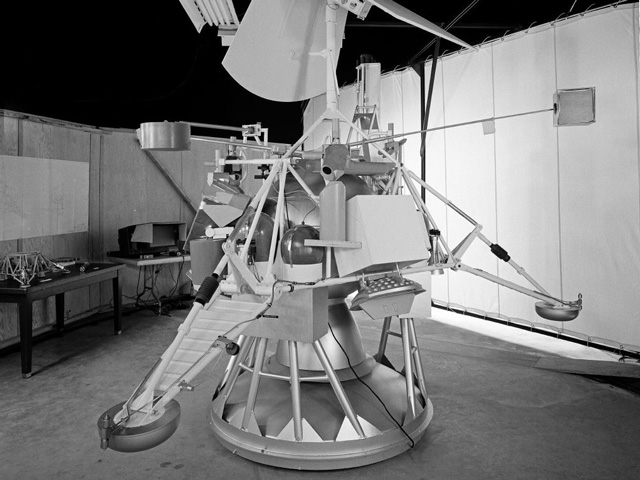
Scientists using the Pan-STARRS1 survey telescope and the Center for Near-Earth Object Studies (CNEOS) made the determination.
Per the press release: The Surveyor 2 lunar lander was launched toward the Moon on Sept. 20, 1966, on an Atlas-Centaur rocket. The mission was designed to reconnoiter the lunar surface ahead of the Apollo missions that led to the first crewed lunar landing in 1969. Shortly after lift-off, Surveyor 2 separated from its Centaur upper-stage booster as intended. But control of the spacecraft was lost a day later when one of its thrusters failed to ignite, throwing it into a spin. The spacecraft crashed into the Moon just southeast of Copernicus crater on Sept. 23, 1966. The spent Centaur upper-stage rocket, meanwhile, sailed past the Moon and disappeared into an unknown orbit about the Sun.
Next up, a little “light” news. Researchers have measured what is now the shortest time ever – 247 zeptoseconds. It is the amount of time it takes for a photon to get from one side of a hydrogen atom to the other side. A zeptosecond is a trillionth of a billionth of a second. In somewhat more understandable terms, “there are as many zeptoseconds in one second as there are seconds in 2,500 times the age of the universe, which is about 13.8 billion years old.”

How did they get this measurement? They bombarded hydrogen gas with X-ray light. As the X-ray photons hit the hydrogen atoms, it ejected one electron and then another. These two electrons caused a wave in the gas, spreading out like ripples in a pond. Since they each started a wave pattern, the patterns overlapped and created an interference pattern. Had the electrons been ejected at the same time, the pattern would have been symmetrical around the center of the H2 molecule; however, the electron waves were slightly off from one another, and the time lag was what gave the researchers the 247 zeptoseconds measurement.
All of this was done using a reaction microscope, and the results were published in Science.
Speaking of science, the groundbreaking science book Philosophiae Naturalis Principia Mathematica, or Newton’s Principia, was first published in 1687. A team at Caltech recently completed a new census of copies of that first edition, and in very good news, they more than doubled the number cataloged in the previous census, done in 1953. That brings the total number of surviving first editions to 386, and they estimate that another 200 or so are still out there, uncatalogued in private collections.

Even more interesting: [B]y analyzing ownership marks and notes scribbled in the margins of some of the books, in addition to related letters and other documents, the researchers found evidence that the Principia, once thought to be reserved for only a select group of expert mathematicians, was more widely read and comprehended than previously thought.
A portion of the newly cataloged copies was found in eastern Europe, which would have been behind the Iron Curtain when the last census was done. First edition copies sell for anywhere from $300,000 to $3,000,000, and they were originally published thanks to funding from fellow scientist Edmond Halley, of Halley’s Comet fame. You can get your own modern version of Principia at local and online bookstores for far less, though.
Finally, we are pleased to announce that SpaceX has received the first certification of a Human-Rated Commercial Space System, in time for this weekend’s Crew-1 launch to the International Space Station.
NASA Administrator Jim Bridenstine said: “I’m extremely proud to say we are returning regular human spaceflight launches to American soil on an American rocket and spacecraft. This certification milestone is an incredible achievement from NASA and SpaceX that highlights the progress we can make working together with commercial industry.
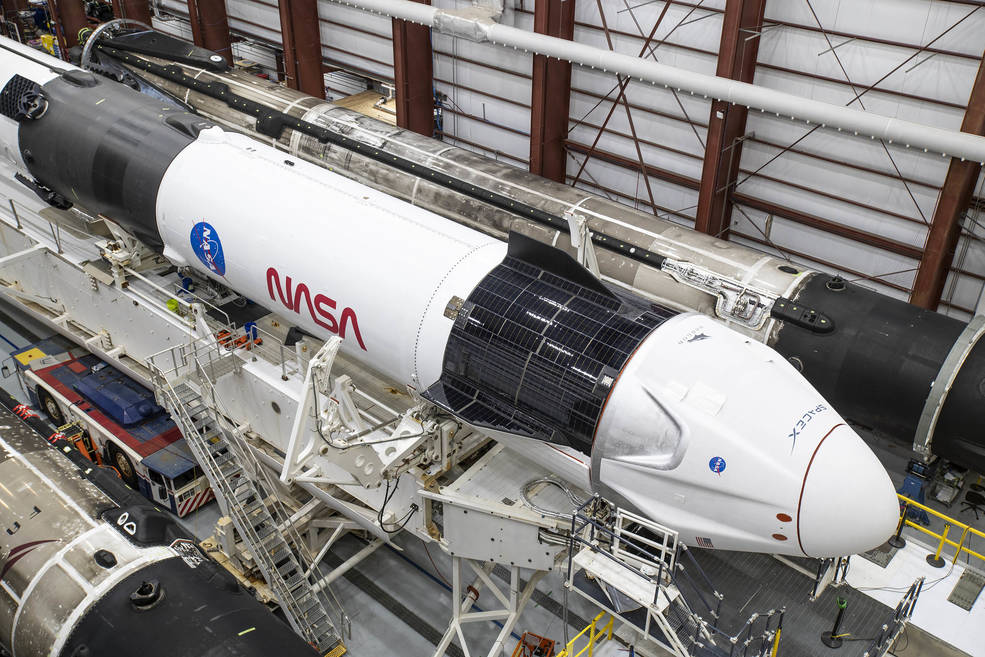
And, weather permitting, we will be bringing coverage of the Crew-1 launch to you live, starting Saturday, November 14, at 4:30 pm PST / 7:30 pm EST / 2430 UTC, on our Twitch channel, twitch.tv/cosmoquestx. Please join us for all the launch festivities! [Ed. Note: The launch stream time has been rescheduled for Sunday, November 15, 6:00 pm PST / 9:00 pm EST / 0200+1 UTC.]
This has been the Daily Space.
Learn More
Truth Uncovered About Luminous Infrared Kilonova
- Center for Astrophysics | Harvard & Smithsonian press release
- Keck Observatory press release
- HubbleSite press release
- Northwestern University press release
- “The Broad-Band Counterpart of the Short GRB 200522A at z = 0.5536: A Luminous Kilonova or a Collimated Outflow with a Reverse Shock?” W. Fong et al., 2020 Nov. 12, Astrophysical Journal (preprint on arxiv.org)
Surprisingly Little Water Has Escaped from Venus
Escape from Mars: How Water Fled the Red Planet
- The University of Arizona press release
- “Hydrogen Escape from Mars Is Driven by Seasonal and Dust Storm Transport of
Water,” Shane W. Stone et al., 2020 Nov. 13, Science
Radioactive Elements May Be Crucial to Rocky Planets’ Habitability
- UCSC press release
- “Radiogenic Heating and Its Influence on Rocky Planet Dynamos and Habitability,” Francis Nimmo et al., 2020 Nov. 10, Astrophysical Journal Letters
A little-known Mass Extinction and the Dawn of the Modern World
- EOS article
- “Extinction and dawn of the modern world in the Carnian (Late Triassic),” Jacopo Dal Corso et al., 2020 Sept 16, Science Advances
New Radio Images of Galaxies in the Perseus Cluster
- National Radio Astronomy Observatory press release
- “High-Resolution VLA Low Radio Frequency Observations of the Perseus Cluster: Radio Lobes, Mini-Halo and Bent-Jet Radio Galaxies,” Marie-Lou Gendron-Marsolais et al., 2020, Monthly Notices of the Royal Astronomical Society (preprint on arxiv.org)
Earth May Have Recaptured a 1960s-era Rocket Booster
A photon’s journey through a hydrogen molecule is the shortest event ever timed
- ScienceNews article
- “Zeptosecond birth time delay in molecular photoionization,” Sven Grundmann et al., 2020 Oct 16, Science
Hundreds of Copies of Newton’s Principia Found in New Census
- Caltech press release
- “A Preliminary Census of Copies of the First Edition of Newton’s Principia (1687),” Mordechai Feingold & Andrej Svorencík, 2020 Sep. 2, Annals of Science
NASA and SpaceX Complete Certification of First Human-Rated Commercial Space System
Credits
Written by Pamela Gay and Beth Johnson
Hosted by Pamela Gay and Beth Johnson
Audio and Video Editing by Ally Pelphrey
Content Editing by Beth Johnson
Intro and Outro music by Kevin MacLeod, https://incompetech.com/music/


 We record most shows live, on Twitch. Follow us today to get alerts when we go live.
We record most shows live, on Twitch. Follow us today to get alerts when we go live.